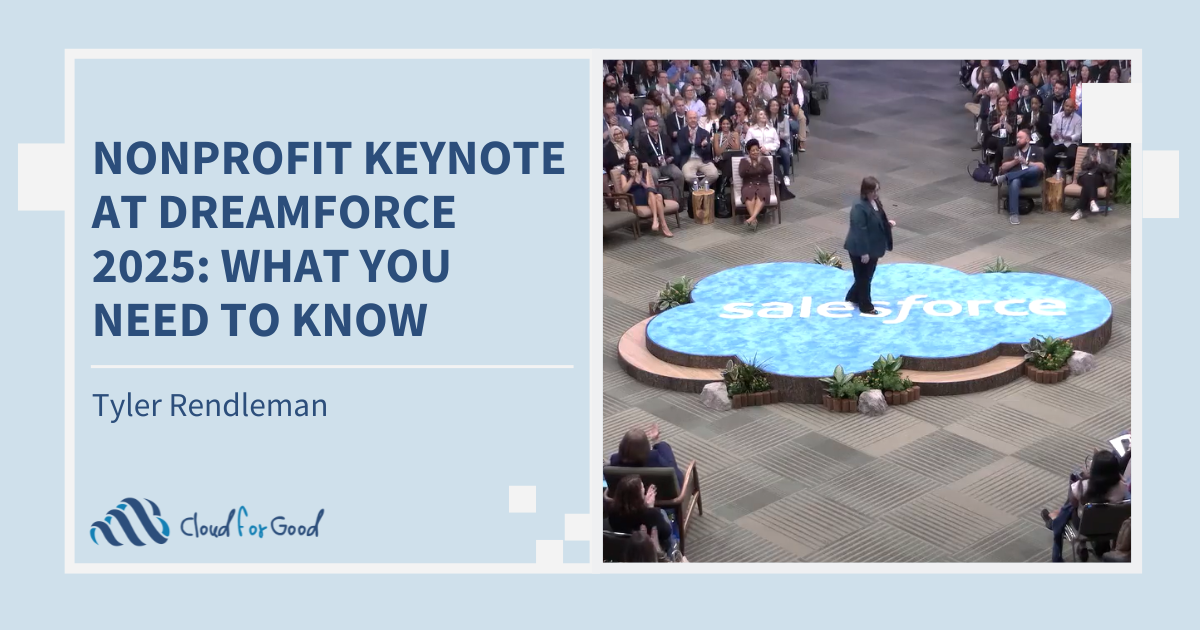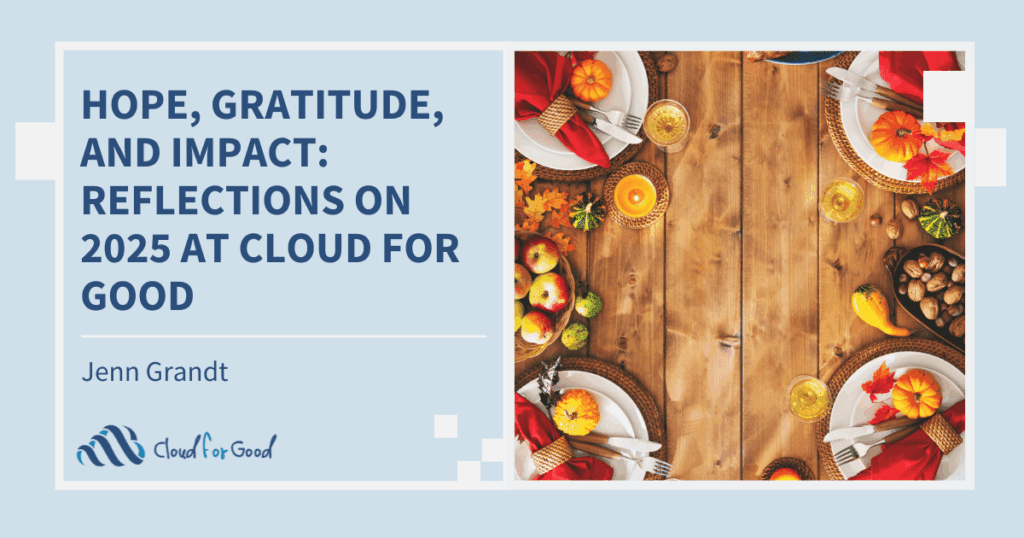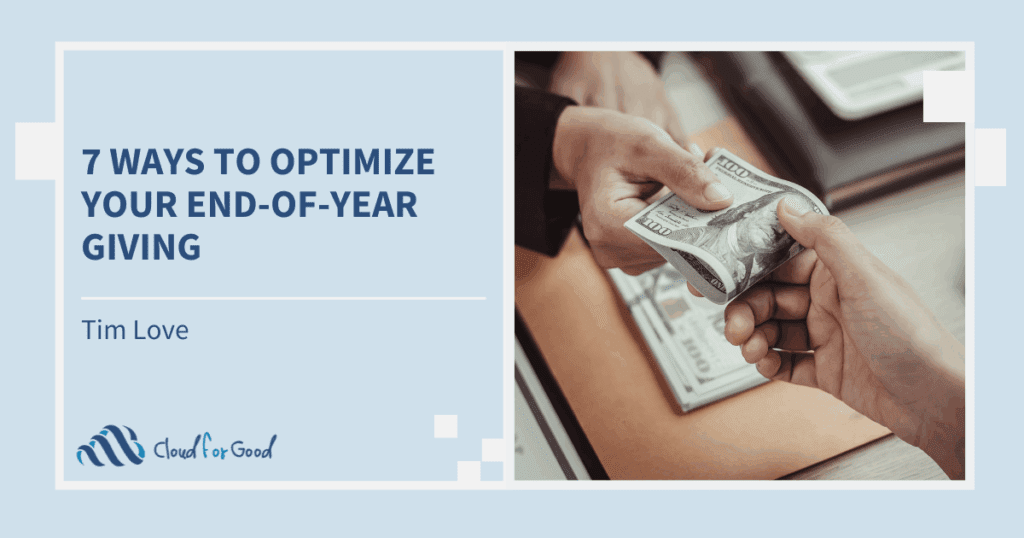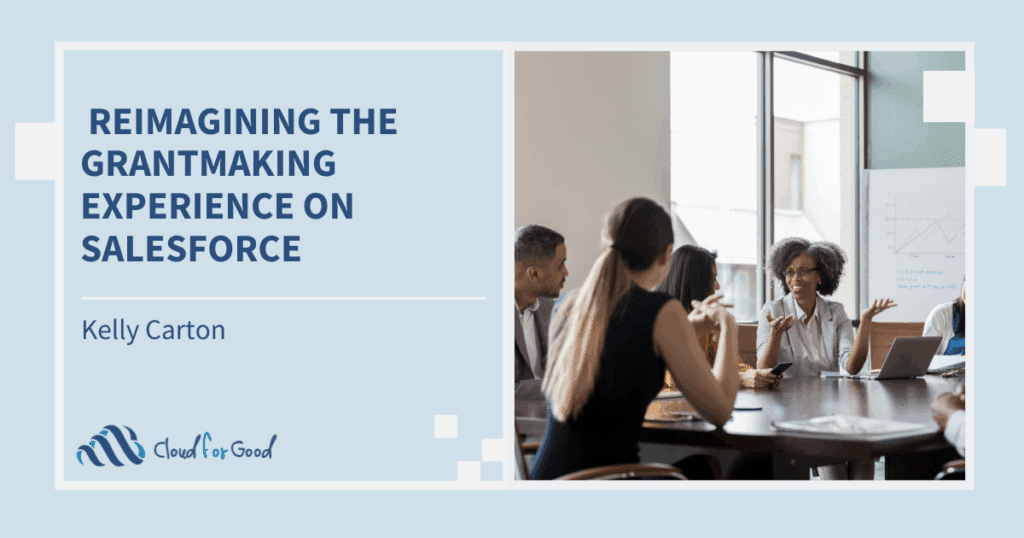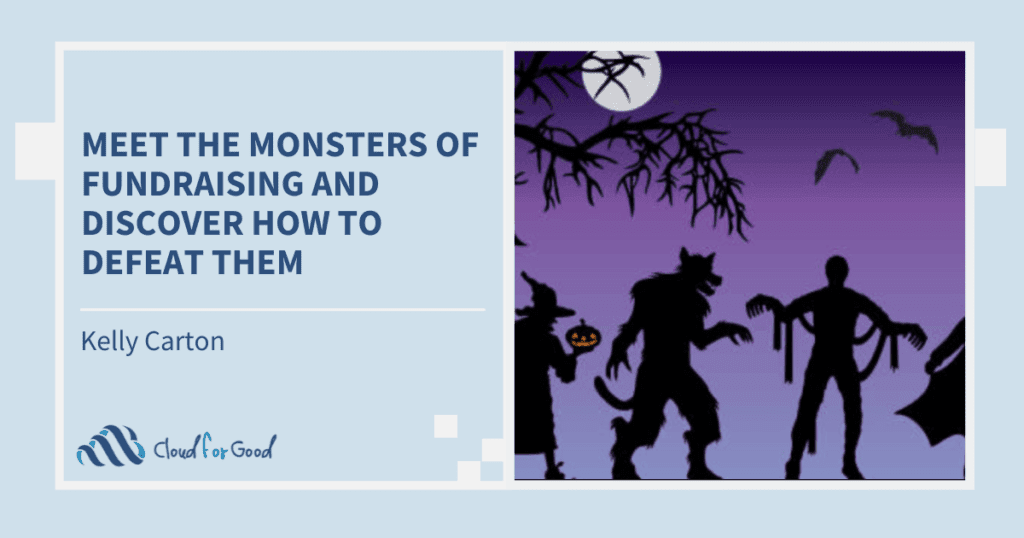At last year’s Dreamforce 2024 conference’s nonprofit keynote, leaders from Salesforce’s nonprofit team shared exciting announcements about innovations to Nonprofit Cloud, and a glimpse of its nonprofit product roadmap plans. Salesforce nonprofit leaders also spotlighted and discussed Agentforce, Salesforce’s (then) newly launched, groundbreaking agentic AI layer, and the various challenges and nonprofit-specific use cases that Agentforce AI agents in collaboration with human workforces could solve to maximize efficiency and scale impact. Since then, Salesforce has made continuous innovations in Nonprofit Cloud and Agentforce to enhance operations and unlock even more opportunities for impact at nonprofit organizations. At the nonprofit keynote at Dreamforce 2025, Cloud for Good and other nonprofit Trailblazers learned about some of these innovations and how agentic AI is not here to replace people; but to augment them and help them tackle the sector’s biggest challenges—funding and workload management—as a new, powerful digital ally. Here is what you need to know about the biggest innovations announced at the nonprofit keynote at Dreamforce 2025 for nonprofits, what they do, and how nonprofits can start using them to scale their impact.
Agentic AI Can Help Nonprofits Solve Increasing Operational Challenges and Scale Impact
The keynote didn’t shy away from the realities nonprofits face. Salesforce leaders first discussed the operational challenges that nonprofits are facing today, with raising sufficient funds, managing workloads, and an increased demand for services being the key areas.
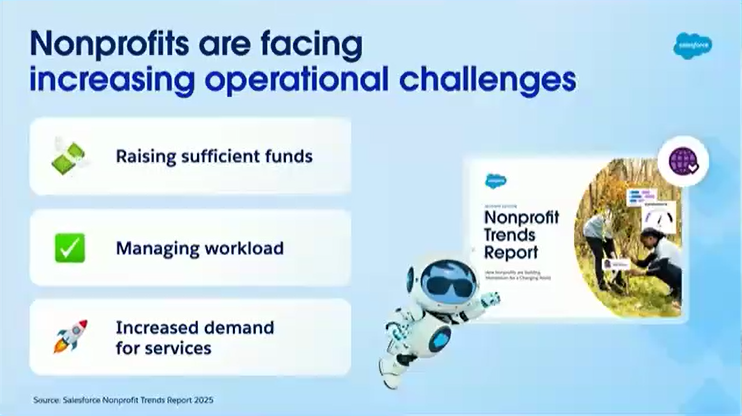
The good news? AI adoption is increasing in response. Nonprofits are turning to AI to help them solve these challenges, consequently leading to an increase in AI adoption—Salesforce found that the percentage of nonprofits piloting or using AI jumped from 12% in 2024 to 54% in 2025. The top use cases that Salesforce found nonprofits were leveraging AI for were fundraising, program design, service delivery, marketing and communications, and impact reporting.
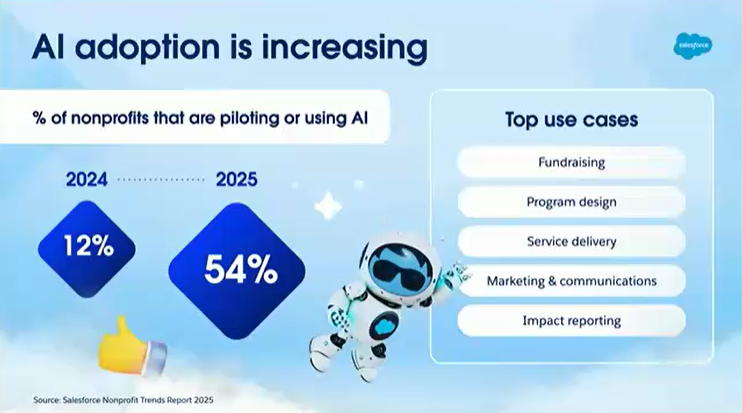
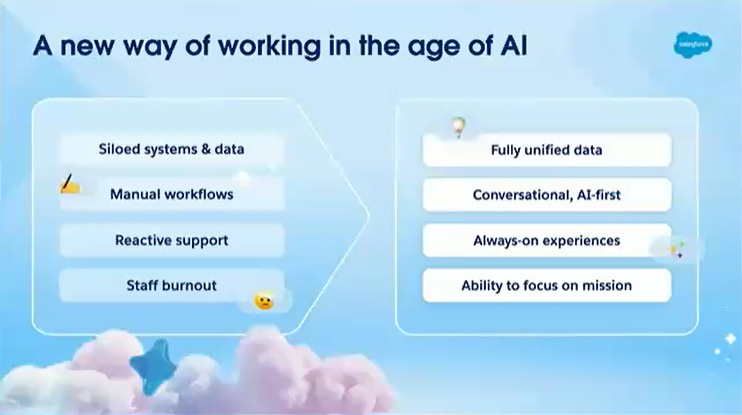
Announcing Agentforce 360 for Nonprofits
This new “agentic” era, as Salesforce calls it, is about moving organizations from manual workflows to conversational, AI-first engagement and from staff burnout to a renewed focus on mission. In order to meet this agentic era moment, Salesforce unveiled a significant evolution: Agentforce 360 for Nonprofits (previously Nonprofit Cloud), with Agentforce Nonprofit.
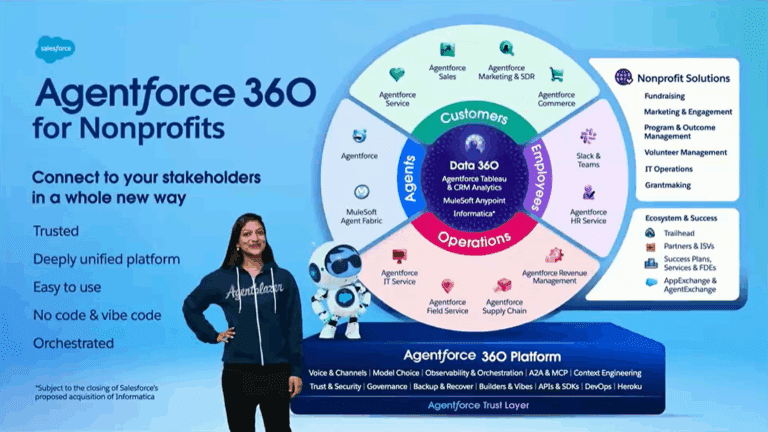
Global GM & VP, Nonprofit Solutions & Strategy at Salesforce Lori Freeman explained that Agentforce 360 for Nonprofits is more than a name change. It reflects a fundamental shift in Salesforce’s investment, designed to give nonprofits’ fundraising, program management, grantmaking, and volunteer management tools true “agency”. Agentforce Nonprofit is a holistic solution set built on a single, trusted platform, Agentforce 360, that unifies nonprofits’ data, enabling AI to work for them.
Product Announcements for Agentforce Nonprofit
Perhaps the keynote’s most exciting news was the announcement of three new agents that are now or will soon be generally available (GA) to help solve core nonprofit challenges.
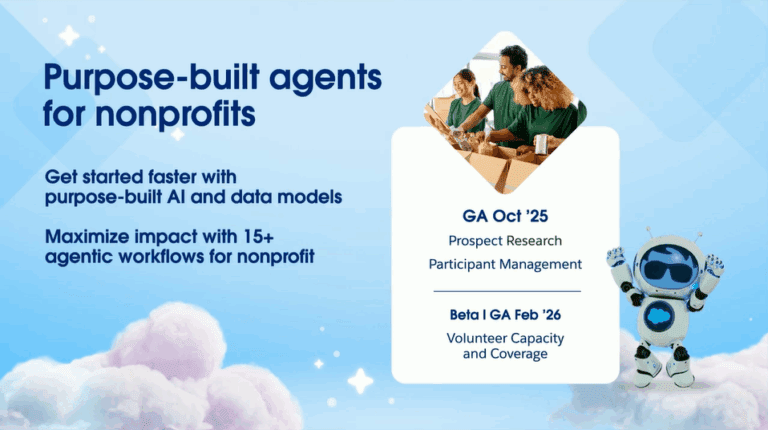
- Prospect Research Agent (GA Now): Directly targeting the #1 challenge of fundraising, this agent helps nonprofit staff members get to major gifts faster by supercharging their prospect research efforts.
- Participant Management Agent (GA Now): Can summarize a client’s entire history and log interactions from a simple conversational prompt. This agent was built to ease administrative burden for Salesforce customer Pacific Clinics, which took the stage during the keynote. With their Participant Management Agent, Pacific Clinics is already saving 650 hours a month per program.
- Volunteer Capacity and Coverage Agent (Beta | GA February 2026): Designed to work alongside the new native Volunteer Management solution in Agentforce Nonprofit. This agent helps nonprofit teams identify and fill volunteer shifts, ensuring their programs are never short-staffed.
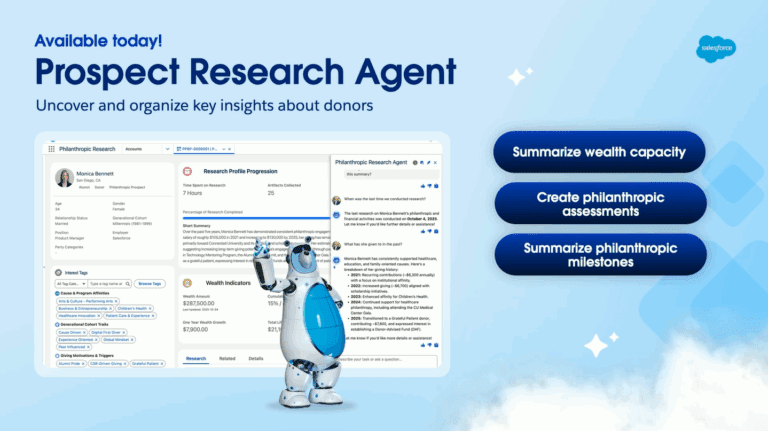
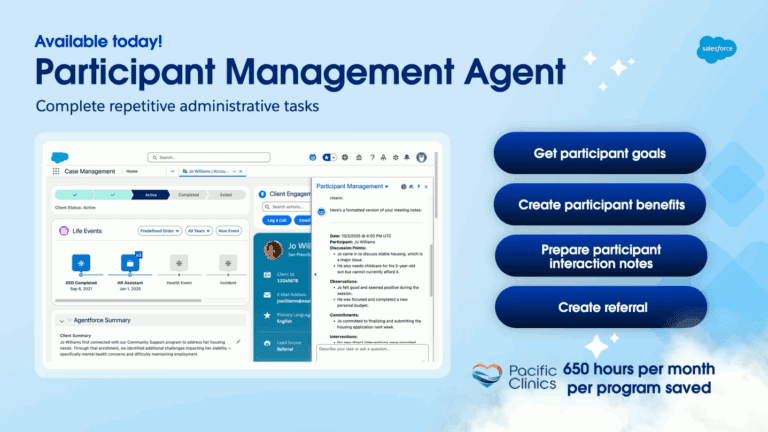
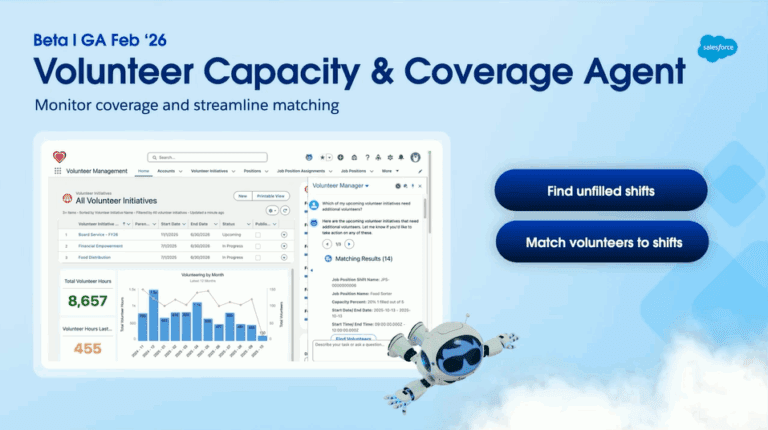
Getting Started With Building An Agent: A Live Agent Demo in Under 19 Minutes
For anyone feeling overwhelmed, Salesforce Lead Technical Architect Jared Jones demystified the agent-building process by building an agent live during the keynote.
At the start of the keynote, audience members were given a poll to select what kind of nonprofit use case Jared should build an agent for during the keynote. The poll’s results showed that fundraising was the audience’s top-requested use case. In 18 minutes and 15 seconds, Jared built a working prototype for a matching gift fundraising agent designed to:
- Identify a new donation from a corporation (in the demo, “Omega Inc.).
- Understand the user’s request: Asking the agent, “Can you create a soft credit record for Alex Garcia?“
- Handle ambiguity by asking the user to confirm the correct “Alex Garcia” record when multiple records were found.
- Create the soft credit record when requested, all from a simple conversation in natural language.
Jared’s advice for getting started was simple and powerful:
- It all starts with the idea: The technology is the easy part. The most important thing is having a clear point of view on where an agent can add the most value.
- Target repetitive work: Look for tasks like repetitive data entry that agents can do faster, freeing up humans for mission-focused work.
- Go from idea to prototype in minutes: This isn’t a year-long project. As the demo proved, you can build and test a prototype incredibly quickly to see if your idea works.
Conclusion: Agentic Nonprofits Scale Impact & Just Get Started
In addition to Pacific Clinics, the keynote showcased several additional incredible examples of purpose-built agents in real life that are helping nonprofits augment their operations and scale impact at their organizations, from Good360’s Resource Matching Agent, which triples the speed of disaster-relief donation matching, to America on Tech’s Grant Agent, which reduced grant reporting time from four days to one hour.
One other dominant message from the keynote’s speakers on becoming an agentic nonprofit was to just get started. They encouraged nonprofit leaders in the audience to not wait for the “next iteration”. Salesforce’s Agentforce technology is moving faster than anything before it, and the tools to make an nonprofit “agentic”—where work is conversational and employees are augmented —are here today.
With its expertise in nonprofit implementations and as an Agentforce partner, Cloud for Good is looking forward to helping nonprofits become agentic nonprofits in this new agentic era.
Contact our team today to learn how we can help you become an agentic nonprofit and build agents at your organization to scale impact and drive change.
You Might Also Enjoy:
Blog: Public Sector Keynote at Dreamforce 2025: What You Need to Know
Success Story: When Mission Meets Salesforce: Jewish Community of Louisville’s Blueprint for Connected Fundraising Impact
Blog: Agentforce for Nonprofits and Higher Education: What You Need to Know
Blog: Salesforce Has a New Vision for Nonprofit Cloud, What Does This Mean for Your Organization?

